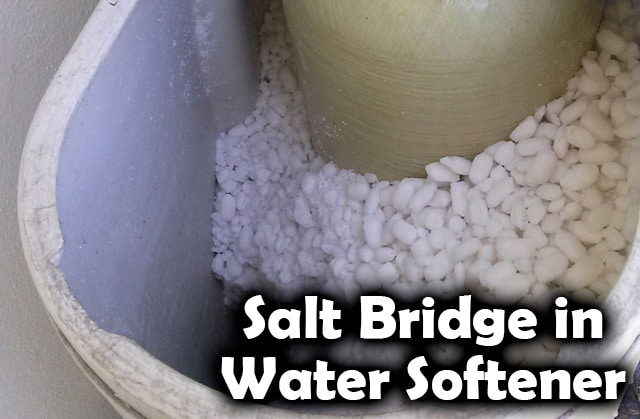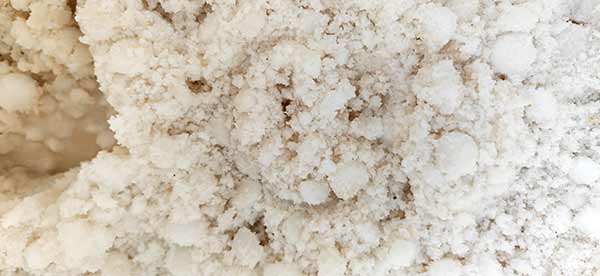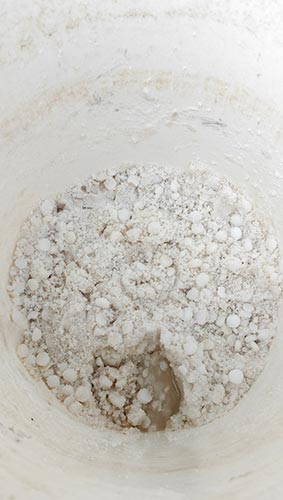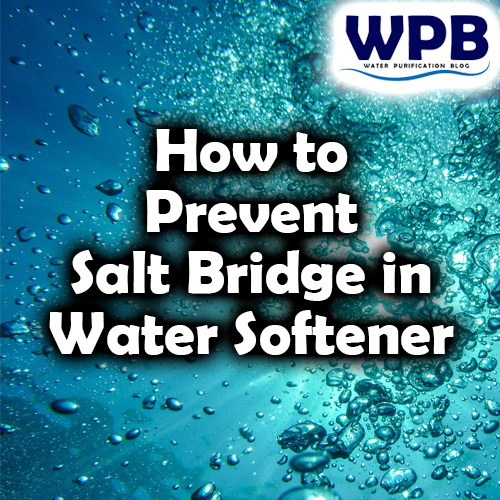What is a Water Softener Salt Bridge?
A salt bridge occurs when a hard crust or bridge forms in the brine tank of a water softener, preventing the water from below the bridge to dissolve the salt. The bridge is created when the moisture in the surrounding is low, the quality of the salt is low, and the salt at the top of the tank clumps together, forming a hard layer over the whole cross section of the tank.

Table of Contents
What Causes a Water Softener Salt Bridge?
There are several reasons why salt bridges can occur in water softeners, including:
High Humidity
High humidity levels can cause the moisture in the tank to evaporate slowly, which leads to the formation of a hard layer of salt above the water level.
Wrong Type of Salt
Using the wrong type of salt can cause salt bridges to form. It’s essential to use high-purity salts specifically designed for water softeners.

While rock salt is the least expensive, it contains more impurities that can contribute to the formation of bridges.
Solar salt is relatively pure and dissolves well, making it a better choice.
However, evaporated salt is the purest and is less likely to form bridges due to its high solubility.
Brine Tank Shape and Size
The shape and size of the brine tank can also contribute to the formation of salt bridges. If the tank is too shallow or too large, it can create an uneven layer of salt at the bottom, leading to the formation of a salt bridge.
Brine tank is too large and the water consumption too low
If the brine tank is too large and the water consumption too low, the period between regenerations can be too long. This will help the brine solution in the salt tank to evaporate, and the top of the salt to dry out.
This can often cause and help in the formation of a salt bridge.
How do I stop my water softener salt bridge formation?
Preventing salt bridges is crucial for maintaining the efficiency of your water softener. Here are some steps you can take to prevent salt bridges:
Use High-Purity Salt
Using high-purity salts specifically designed for water softeners can prevent salt bridges from forming.
Break Up Any Bridges
If you notice a salt bridge forming, use a long object like a broom handle to break it up.
Regularly Clean the Brine Tank
Regularly cleaning the brine tank can prevent salt buildup and the formation of salt bridges.

How to Fix a Salt Bridge in a Water Softener?
If a salt bridge has already formed in your water softener, here’s how to fix it:
Use a Long Object to Break Up the Bridge
Use a long object like a broom handle to break up the salt bridge. Try to hit the salt bridge and to break it into smaller pieced.
Be careful not to damage the salt tank and the brine suction valve.
Remove the Salt Bridge Pieces and Old Salt from the Brine Tank
Once the salt bridge is broken up, remove the hard pieces of the bridge and any undissolved salt from the tank. It is best to remove even the loose salt tablets.
Take out the brine valve, and clean it as much as possible.
Clean the whole inside of the tank with warm water.
Add New High Quality Salt to the Brine Tank
Add fresh salt to the tank, making sure to fill it to the appropriate level. In most cases You can fill around 2/3 of the tank with salt.
Try to use only the manufacturer approved salt or other high quality salt intended for water softening.
After filling the tank with salt, also pour water so You can just see it at the salt level.
Manually Regenerate the Water Softener
Start a manual regeneration of the water softener to ensure that the ion exchange resin is regenerated and your water softener system is working correctly.
The regeneration should be started at least an hour after adding new salt and water to the brine tank. This is important so the salt has time to dissolve and create a saturated brine solution.
Conclusion about How to Prevent Salt Bridge in Water Softener
Preventing a water softener salt bridge requires proactive measures, including selecting the right type of salt, regular maintenance, proper setup, humidity control, and addressing existing salt bridges promptly.
By implementing these strategies, you can ensure the efficient and uninterrupted water softening performance of your softener.

Who am I?
I am working as a water treatment technical manager and I have more than 25 years of practical experience in water purification.
Water purification expert
After many years of experience in water purification, I want to share some of my knowledge and get people to know the real importance of water quality.
Water purification and water treatment are very complex themes, so it is important to explain them in an easy-to-read way.
On this blog, you will find many understandable, easy-to-read information about water purification.
I hope you enjoy it, find some useful information, and thank You for reading.
More info on my work and my expertise on water purification can be found on my LinkedIn profile.






